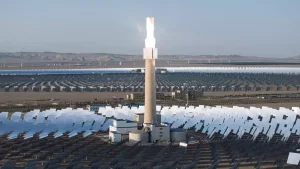An old system is gaining popularity among researchers for its versatility and cost-effectiveness in providing clean fuel.
Concentrated solar power (CSP), which had been nearly driven out of business by low-cost solar photovoltaics, is now making a comeback. Quantum learns that NTPC, the state-owned power generation company, recently sent out probes to several companies asking them if they would be interested in setting up CSP plants; and the response was overwhelming.
A solar power tower works by concentrating the sun’s rays to a point to generate heat
“CSP with thermal storage can provide 24/7 renewable energy at less than Rs 3 per kWh,” says Rajan Varshney, Deputy Managing Director, NTPC, in a LinkedIn post.
While producing electricity from CSP is one option, some others are being explored in the scientific and business world. CSP works by concentrating the sun’s rays at one point to generate heat. Why convert heat into steam and produce electricity? Why not use heat directly?
NTPC wants CSP companies to produce and sell hot steam, which reduces the load on boilers to heat the steam, meaning burning less coal and reducing carbon footprint. Others suggest that the heat from CSP can be used to produce hydrogen.
Professor KS Reddy and Saurabh Mohite of the Thermal Energy and Heat Transfer Laboratory, Department of Mechanical Engineering, IIT-Madras, have recently published the results of their research on photoelectrolysis of water using heat from CSP.
His method is simple. Use the heat produced by the CSP plant to heat zinc oxide, splitting it into zinc and oxygen. If you put zinc in water, the metal will pick up oxygen from the water to form zinc oxide again, leaving hydrogen in the water. The second reaction, the hydrolysis of zinc, releases heat, approximately 104 KJ/mol. This is less than the 456 KJ/mol required by the first reaction, but there is some additional heat from the second reaction. In a paper published in Energy Conversion and Management, Reddy and Mohite say the method produces significantly more hydrogen. “Although CSP is an old system, it is gaining popularity among researchers for hydrogen production due to its high temperature applications in the range of 500 to 2000°C,” the paper notes.
Also, it doesn’t have to be zinc oxide; Any metal oxide will work, although the performance of each would need to be studied.
CSP technologies come in different forms: parabolic trough collectors (PTC), linear Fresnel reflectors, parabolic troughs and solar power towers (SPT). In 2020, the world had 6.5 GW of CSP, most of it from PTC. However, solar power towers are gaining more attention because they can achieve high solar concentration factors (more than 1,000 sols) and operate at higher temperatures, 1,000 °C and above. «SPT presents greater room for improvement and greater potential for cost reduction due to higher solar-to-electric conversion efficiency, higher power densities, a low-cost solar field, less maintenance and oil-free plants with lower impact environmental». says Javier Bigorri et al of the National Center for Renewable Energies, Navarra, Spain.
Experts now suggest combining CSP plants with solar PV and wind power, so that the same system is used to store electricity from multiple sources. The conventional way to store CSP energy has been through molten salts, but more advanced storage technologies linked to CSP are emerging: (i) sensible heat storage including new molten salts, sensible packed bed thermocline and liquid metals; (ii) Latent Heat Storage: phase change materials in packed bed thermocline and (iii) Thermochemical Energy Storage: hydrides, hydroxides, carbonates and redox reactions.
In short, CSP is gearing up for its second entry.




